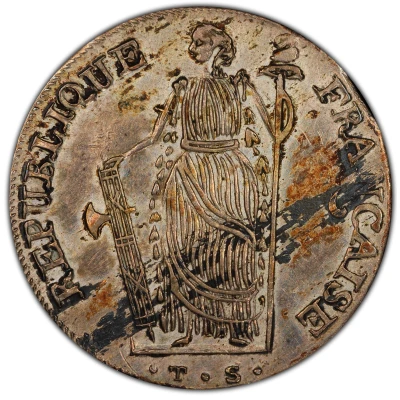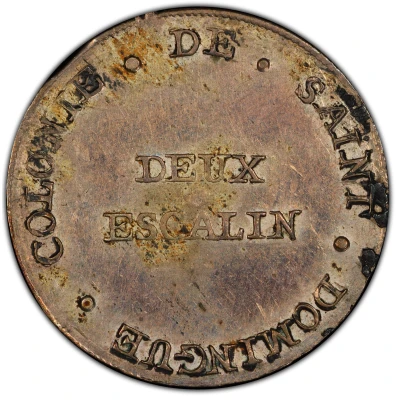


© PCGS
2 Escalins ND
1802 year| Silver | 25 g | 23 mm |
| Issuer | Haiti › Saint-Domingue (1625-1804) |
|---|---|
| Type | Standard circulation coin |
| Year | 1802 |
| Value | 2 Escalins (3⁄2) |
| Currency | Livre (1625-1813) |
| Composition | Silver |
| Weight | 25 g |
| Diameter | 23 mm |
| Thickness | 2 mm |
| Shape | Round |
| Orientation | Coin alignment ↑↓ |
| Demonetized | Yes |
| Updated | 2024-10-05 |
| Numista | N#119218 |
|---|---|
| Rarity index | 95% |
Reverse
Denomination
Script: Latin
Lettering:
COLONIE. DE. SAINT. DOMINGUE.
DEUX
ESCALIN
Translation:
Colony of Santo Domingue
Two Escalins
Edge
Plain
Comment
Authorized by the Ordinance of 15 Nivose An X (January 5, 1802) issued by then Governor Toussaint Louverture, the present issue was struck in Santo Domingo and commissioned (per Zay, based on a contemporary report by General Kerverseau) to a French citizen named Tixier. Some researchers including Estrella and Lissade have proposed a probable European (English) origin for the dies, due to their relative high engraving quality. Mintage figures for this issue remain unknown.Interesting fact
The 2 Escalins coin from Haiti, minted in 1802, is interesting because it was issued during a time of great turmoil and change in the country. Haiti was then known as Saint-Domingue, a French colony that was home to a large population of enslaved Africans. The Haitian Revolution, which began in 1791, was a slave revolt that ultimately led to the establishment of Haiti as the first independent black nation in the world in 1804. The 2 Escalins coin was likely minted during this time of transition, making it a unique piece of history that reflects the complex and tumultuous period in which it was created.